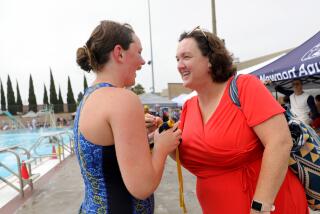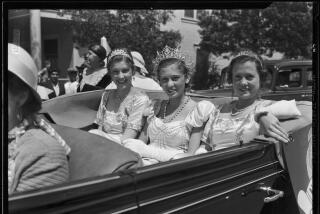Bess Myerson, Miss America who rose in politics and fell in scandal, dies at 90
Bess Myerson, the former beauty queen, television personality and New York politician who spent four decades in the public eye before her glamorous image was tarnished by scandal, has died. She was 90.
Myerson died Dec. 14 at her home in Santa Monica. The Los Angeles County Coroner’s Office confirmed her death, which was not publicly announced.
Myerson was an aspiring pianist in 1945 when she became the first Jewish Miss America and a symbol of ethnic pride for Jews emerging from the brutal realities of World War II. She went on to a career as a game show hostess and panelist before entering political life in the 1960s.
As consumer affairs commissioner in the administration of New York Mayor John V. Lindsay, she successfully crusaded for such reforms as unit pricing and open dating of perishable foods, early victories in the consumer protection movement of the 1970s.
Alternately regal and folksy, she became one of the most powerful women in New York politics, credited as a driving force behind the electoral success of Mayor Edward I. Koch in 1977.
Later, she was forced to resign as Koch’s cultural affairs commissioner when she was accused of bribery and conspiracy to influence the divorce case of a multimillionaire sewer contractor who was her boyfriend. She was acquitted of all charges after a four-month trial in 1988, but she never returned to public life.
She overcame ovarian cancer, a stroke and the breakup of two marriages while struggling with issues of family and career — years before the women’s movement made such balancing acts acceptable.
Myerson “aspired to be more than just a beauty queen, and she succeeded like no other before or since,” New York journalist Jennifer Preston wrote in “Queen Bess,” a 1990 biography.
A complex woman whose erratic behavior sometimes mystified those closest to her, she rebuffed efforts to peg her as an early feminist.
“When someone says to me, ‘You’re a forerunner of the women’s movement,’ I say that is bull ...” Myerson said in 1982. “I worked my butt off. I had to survive.”
She was one of three children of Louis and Bella Myerson, both Russian Jewish immigrants. The firstborn, a son, died at age 2 of pneumonia. Myerson was the youngest, born on July 16, 1924.
She was raised with an enthusiasm for Yiddish culture among the poets, writers, painters, meat cutters and garment workers who lived at the Sholem Aleichem housing project in New York’s Bronx. Scholarship, not beauty contests, was the priority in the Myerson household. Her mother in particular pushed her to study music from an early age, believing that Myerson would be able to support herself later by giving lessons. She practiced for hours every day, not always willingly, and won admission, at age 13, to the High School of Music and Art in Manhattan. She went on to major in music at Hunter College.
She would spend much of her life trying to win the approval of her hyper-critical mother, who barked commands about piano practice and homework with the intensity of a drill sergeant. Myerson would often tell people later that Bella Myerson rarely found anything nice to say about her daughter, even when she made her Carnegie Hall debut at age 22.
Her height also made her insecure: Myerson was 5 feet 10 by the time she was 12. One of her unhappiest childhood memories was being forced to play the role of Olive Oyl, the gangly character from the Popeye cartoon, in a school play.
Being so tall was “such a handicap,” she told New York magazine in 1987.” A lot of the poignant parts of me have to do with my height. I had to protect myself because other people wouldn’t protect me. Even today, I’m always amazed at how people observe me. There’s always great strength attributed to me. But inside there’s a little girl trying to get out. Sometimes I just need someone’s arms around me.”
During the summer of 1945 she was working as a camp counselor when her sister Sylvia conspired with a photographer friend to enter Myerson in the Miss New York City competition sponsored by a local radio station. The winner would go on to compete in the Miss America pageant, which for the first time was offering a $5,000 scholarship to the young woman who won the crown. The money could help Myerson purchase the Steinway baby grand of her dreams.
She competed in a borrowed swimsuit and played a three-minute arrangement of Grieg on the piano and Gershwin on the flute. Although she felt like “the wrong person in the wrong place,” she won the New York City title.
Before she headed off to Atlantic City, the director of the Miss America pageant had a private talk with Myerson. Sensing that she was a strong contender for the crown, she advised Myerson to change her name to make it more “attractive” for a career in show business. She meant a less Jewish-sounding name, such as Betty Merrick or Betty Meredith. But Myerson refused.
“Already I was losing my sense of who I was; already I was in a masquerade, marching across stages in bathing suits,” Myerson told Susan Dworkin, who wrote a 1987 book about Myerson’s year as a beauty queen, “Miss America, 1945: Bess Myerson’s Own Story.” “Whatever was left of myself in this game, I had to keep, I sensed that. I knew I had to keep my name.
“It turned out to be one of the most important decisions I ever made.”
She would later recount being stopped by an elderly Jewish woman in Atlantic City who asked Myerson if she was Jewish. When she said yes, the woman hugged her and told her to win “for all of us.” Myerson realized then that she was “not merely a girl seeking a scholarship but a symbol of Jewish yearnings for good news.”
In the pageant program for 1945 all the contestants were wearing bathing suits except for Myerson, who wore her collegiate cap and gown. A headline from the time called her “A Very Serious Type.”
“The Miss America pageant was the weirdest focus she could possibly have,” Dworkin said. “It’s not in the nature of her upbringing. It was a ticket.”
Myerson successfully performed the same Grieg and Gershwin combination that had helped her win the New York City contest. And she overcame a problem with a too-snug swimsuit to win that category as well.
On Sept. 8, 1945, she became the first Miss America of the post-war era. But what she hoped would be a glorious year instead was disillusioning.
She performed on the vaudeville circuit for several weeks, earning $4,000, but stopped when she realized that audiences wanted to see her in a bathing suit more than hear her play the piano. She waited for lucrative sponsorships to pour in, but they never did. While touring the country, she encountered “No Jews” signs outside hotels in Florida and walked out of a country club in the Northeast after overhearing her host say that Jews, even one who wore a crown, could not be admitted. “I felt so rejected,” she later recalled. “Here I was, chosen to represent American womanhood, and then America treated me like this. It was shattering.”
As the winter of 1945 approached, she was running out of things to do. So when the Anti-Defamation League approached her about going on the lecture circuit, she leaped at the opportunity. “You Can’t Be Beautiful and Hate” was the title of her speech.
The tolerance campaign turned out to the high point of her year as Miss America. It also led to a new career.
A television producer named Walt Framer had heard her speak at an Anti-Defamation League meeting. A few years later he offered her a job on a game show called “The Big Payoff.” From 1951 to 1959 she was “the Lady in Mink”—the Vanna White of her era—who introduced the guests and announced the prizes.
Glamorous and articulate, she also regularly subbed for Dave Garroway as host of NBC’s “Today” show and announced the commercials on the “Jackie Gleason Show” and “Philco Playhouse.” From 1958 to 1967 she was a panelist on “I’ve Got a Secret.” She also emceed the Macy’s Thanksgiving Day Parade and the Rose Parade for many years.
She married Allan Wayne, manager of a family toy business, in 1946. Their daughter, Barbara (who would later change her name to Barra), was born in 1947. They divorced about 10 years later.
Myerson remarried in 1962 to entertainment lawyer Arnold Grant. Theirs was an acrimonious relationship that ended twice in divorce. They split in 1965, wed again in 1968, then divorced for the final time in 1970.
Myerson had returned as host of the Miss America pageant in 1954 and filled that role for the next 14 years, until a decision was made to replace her with a younger woman.
She was feeling depressed about her removal from the show when a call came in early 1969 from Mayor Lindsay’s office about a job in his administration. A few weeks later he named Myerson his new commissioner of consumer affairs.
“Ms. Myerson brought visibility to the job,” said Philip Schrag, a professor of law at Georgetown University who was the city’s consumer advocator and litigator at the time. “She was an extraordinarily effective public servant ... and a brilliant and astute executive.”
Telling the press that her main qualification was watching her mother bargain with shopkeepers, she plunged enthusiastically into the work, hiring an energetic legal staff to help her establish tougher consumer protection laws.
A savvy crusader, she used the media to help her educate consumers. She showed up at diners with cameras in tow to investigate whether they were using 100% beef in burgers or less pure “shamburgers.” She criticized “fresh” labels on frozen fish, unlicensed auto repair shops and baby rattles filled with shrapnel.
Her biggest victory was the Consumer Protection Act of 1969, passed by the City Council during her first year in office. It outlawed deceptive practices and gave the city the power to penalize fraudulent merchants and seek mass restitution. It was considered the toughest consumer law in the country. More than $5 million was returned to defrauded customers during Myerson’s tenure.
She also advocated “unit pricing,” which allowed consumers to comparison shop according to the price of an item per ounce, pound or foot. New York’s unit pricing law inspired similar measures in cities around the country.
In 1971 she made the cover of Life magazine as “A Consumer’s Best Friend.” Her successes gave her soaring approval ratings that were the envy of many politicians.
Exhausted from long work days, she resigned in 1973. Political power-brokers such as then-Gov. Nelson Rockefeller urged Myerson to run for mayor, but she decided to focus on her financial security and accepted a lucrative job as a consumer consultant to Citibank. She later assumed a similar post at Bristol Myers.
In 1974 she was diagnosed with ovarian cancer. She recovered but kept her illness secret while gradually reentering the social and political circuits.
In 1977 she campaigned for then-mayoral contender Koch, then a little-known Democratic congressman. By constantly appearing at his side during campaign events she helped dispel rumors that Koch was gay. They were such a hit together that reporters speculated in print about their wedding date.
Koch won, and the following year Myerson began to explore a race for the Democratic nomination for the U.S. Senate in 1980. Downplaying the role that first brought her the national spotlight—her official campaign biography made only a brief mention of her having previously won a “national talent contest”—Myerson tried to portray herself as a woman of the people, invoking her early years in the working-class environment of Sholem Aleichem. But the strategy failed. People joked that she was the “Lady in Mink” while her main rival, no-nonsense Brooklyn Congresswoman Elizabeth Holtzman, was the lady in the cloth coat.
Although she had begun the race as the front-runner, Myerson lost to Holtzman despite a high-powered campaign consultant, the endorsements of Koch, Gov. Hugh Carey and Sen. Patrick Moynihan, and a $1-million campaign fund. Holtzman ultimately lost the race to Alfonse D’Amato.
Myerson was crushed by her defeat and deep in debt, telling People magazine later that “I was dog meat. I couldn’t even find a man to take me to the movies.”
In 1981 she suffered a mild stroke. Although she had difficulty speaking for several months, she eventually recovered fully.
The next year, she published the “I Love New York Diet,” which promised that dieters could lose 10 pounds in seven days. Based on diets developed by New York City’s Bureau of Nutrition, it became a bestseller. It was her second book, the first being a consumer’s guide published in 1979.
In 1983 she asked Mayor Koch to name her cultural affairs commissioner, a position that oversaw funding for the city’s famous museums and other cultural institutions. He had been turned down by such high-profile candidates as Beverly Sills and Jacqueline Onassis and so was delighted to hear that his old friend was interested. Promising to raise more money for the arts from business, she doubled the budget for cultural affairs to $123 million over the four years of her tenure.
Soon after rejoining municipal government, gossip column items began linking her with Andy Capasso, a wealthy sewer contractor she had met while campaigning for the Senate nomination. Married with two children, he was two decades her junior, born the year Myerson was crowned Miss America. They took vacations together and she was driven to appointments in Capasso’s company limousine.
Capasso was in divorce proceedings when Myerson hired Sukhreet Gabel as her assistant. She was the hard-to-employ daughter of state Supreme Court Judge Hortense Gabel, who was handling the Capasso divorce case. Within a month of her daughter’s hiring, Judge Gabel slashed Capasso’s alimony payments, from $1,850 to $680 a week.
The U.S. attorney in New York at the time was Rudolph Giuliani, who was leading prosecutors in a series of government corruption cases. During an investigation of possible tax evasion by Capasso, the government subpoenaed Myerson to appear before a grand jury. She declined to testify, citing her 5th Amendment right not to incriminate herself.
When Koch, who had vowed cooperation with the corruption investigations, heard of his appointee’s refusal to testify, he was livid. He ordered a private investigation and Myerson went on a 90-day unpaid leave. She resigned soon after, declaring that she never helped Capasso get a city contract. She acknowledged hiring Sukhreet Gabel but denied that it was done with any intention of influencing the woman’s powerful mother.
The mayor’s investigation concluded that Myerson had engaged in serious misconduct. Koch later told reporters that his friend was a “strong but alone woman who is in deep trouble.”
Myerson was indicted in late 1987 on charges that she conspired with Capasso and Judge Gabel to cut support payments to Capasso’s estranged wife, Nancy. Myerson also was accused of obstruction of justice for allegedly trying to influence Sukhreet Gabel’s testimony.
The three-month trial was a field day for tabloid journalism, which labeled the scandal “the Bess Mess.”
Myerson told New York magazine writer Patricia Morrisroe that hiring Gabel had been “an unfortunate decision.” But she also said she was convinced that she was being persecuted because “I’m a woman. I’m a Miss America. ... I’m Queen of the Jews. ... I’m the perfect route to the downfall of this [Koch] administration.”
Prosecutors presented mainly circumstantial evidence of bribery and conspiracy against Myerson. The jury deliberated for four days before acquitting her, Capasso and Judge Gabel.
But Myerson’s troubles did not end there. In 1988, she was arrested on shoplifting charges for taking $44 of cosmetics and other merchandise from a store in Williamsport, Pa. She had been in town visiting Capasso, who was serving time for tax evasion at the nearby Allenwood federal prison camp. Wealthy from her years working for large corporations, she was worth an estimated $16 million at the time of her arrest. She pleaded guilty and paid $148 in fines and court costs.
In later years she largely avoided the limelight. She occasionally gave lectures and pursued charity work, mainly for Jewish causes. In 1997 she pledged $1.1 million to the Holocaust Museum of Jewish Heritage in Manhattan. She endowed a $100,000 scholarship fund, the Bess Myerson Campus Journalism Awards, given by the Anti-Defamation League.
She also worked for Share, an organization that provides free support and counseling to women with breast and ovarian cancer.
“Everybody asks me, ‘So what are you doing now?”’ she said some years ago in an interview for Ladies Home Journal. “Why must I be doing something? All my life I’ve been doing. For now, I’m busy being—being quiet, being grateful. Finally, finally, it’s time for me. Not the public Bess Myerson. The private me.”
Myerson’s survivors include her daughter, Barra Grant, a playwright and screenwriter.
Twitter: @ewooLATimes
More to Read
Start your day right
Sign up for Essential California for the L.A. Times biggest news, features and recommendations in your inbox six days a week.
You may occasionally receive promotional content from the Los Angeles Times.







